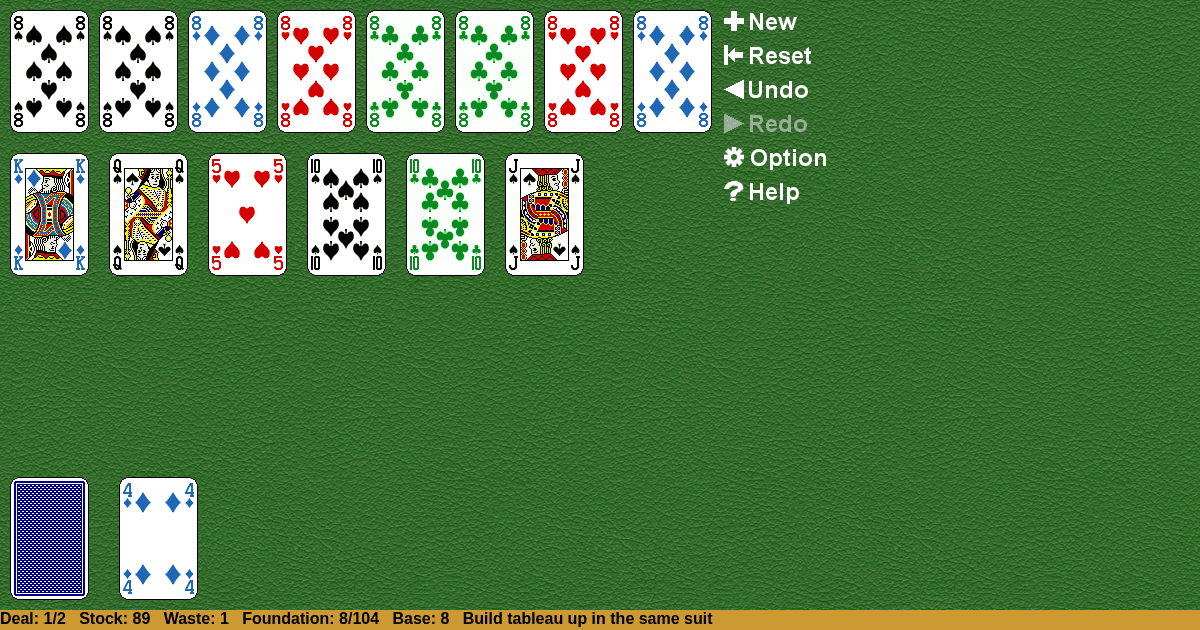Eights Down
Home |
How to play |
FAQ |
About
How to play Eights Down?
Game Objective:
The primary goal in Eights Down Solitaire is to move all cards from the tableau and reserve cells to the four foundation piles, building each foundation in ascending order by suit from Ace to King.
Setup & Layout:
- Deck: Use a standard 52-card deck.
- Tableau: Deal 48 cards face-up into eight tableau columns, with six cards in each column. All cards in the tableau are visible and accessible.
- Cells (Reserve): Place the remaining four cards face-up in the first four of eight available reserve cells (also called "free cells"). The other four cells start empty.
- Foundations: Four foundation piles are positioned separately and start empty.
- Play Areas Defined:
- Tableau: Eight columns where most play occurs; cards are built down in suit.
- Cells (Reserve): Eight slots for temporary card storage; only one card per cell.
- Foundations: Four piles, one for each suit, built up from Ace to King.
Eights Down Solitaire Rules:
- Card Movement:
- Only the top card of each tableau column or any card in a cell is available for play.
- Cards may be moved one at a time; sequences cannot be moved together unless enough empty cells are available to facilitate the move one card at a time.
- Building Sequences:
- Tableau: Build down by suit (e.g., 6♥ on 7♥). Some variants allow building down by alternating color, but the standard rule is by suit.
- Foundations: Build up by suit from Ace to King (e.g., Ace♠, 2♠, 3♠ … King♠).
- Moving to Cells:
- Any available card may be moved to an empty cell; each cell may hold only one card.
- Cards in cells can be moved back to the tableau or to the foundations.
- Empty Tableau Spaces:
- By standard rule, only Kings may be placed in empty tableau columns.
- Some variants allow any card to fill empty tableau spaces; using Kings-only is considered the more challenging rule.
Gameplay:
- Sequence of Actions:
- Move available cards between tableau columns, into cells, or onto foundations, following the building rules.
- Strategically use cells to temporarily hold cards and facilitate moves within the tableau.
- Only one card may be moved at a time, except when enough empty cells allow moving a sequence as if moving one card at a time.
- Introducing New Cards:
- No stock or draw pile exists; all cards are dealt at the start of the game.
- The only new cards entering play are those moved from cells or uncovered in the tableau.
- No Legal Moves:
- If no further legal moves are possible and not all cards are in the foundations, the game is lost.
Winning & Losing Conditions:
- Win Condition: The game is won when all 52 cards are successfully moved to the foundation piles, each built up in suit from Ace to King.
- Lose Condition: The game is lost if no legal moves remain and not all cards are in the foundations.
Special Rules & Edge Cases:
- Filling Empty Tableau Spaces:
- By default, only Kings may occupy empty tableau columns.
- Some variants allow any card to fill an empty tableau space; this should be clarified before play begins.
- Cell Restrictions:
- Each cell may hold only one card at a time.
- Cards in cells can be played back to the tableau or foundations, but only one card per move.
- Sequence Movement:
- Sequences cannot be moved as a group unless there are enough empty cells to facilitate moving each card individually.
- No Stock or Redeal:
- There is no stock pile or redeal; all cards are in play from the start.
- Variant Rules:
- Some house rules or digital versions may allow more flexible filling of empty tableau spaces or sequence movement; always confirm the chosen variant before play.
Key Definitions:
- Tableau: The main play area with eight columns of cards, built down in suit.
- Cells (Reserve): Temporary holding spaces for individual cards, aiding in strategic movement.
- Foundations: Destination piles for each suit, built up from Ace to King.
This guide reflects the standard, most widely accepted rules for Eights Down Solitaire (also known as Eight Off), prioritizing official and reputable sources for accuracy.

Solitaire Collection
About Eights Down
Rate (Eights Down)
4.7 / 5
1,916 votes



























































